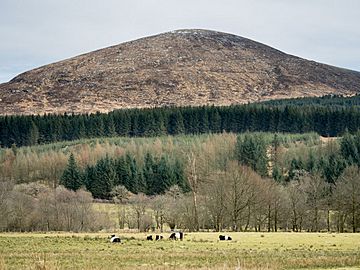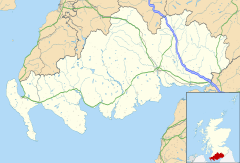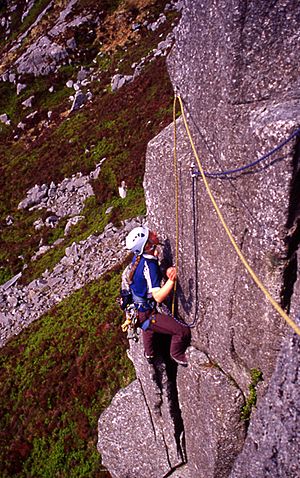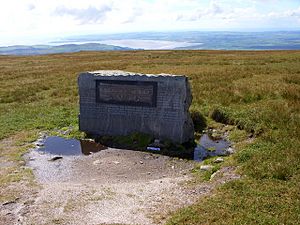Cairnsmore of Fleet facts for kids
Quick facts for kids Cairnsmore of Fleet |
|
|---|---|
 |
|
| Highest point | |
| Elevation | 711 m (2,333 ft) |
| Prominence | 522 m (1,713 ft) |
| Listing | Ma,Hu,Tu,Sim,G,D,DN,Y,P500 |
| Naming | |
| English translation | Scottish Gaelic: Big Hill of Fleet |
| Geography | |
| Location | Dumfries and Galloway, Scotland |
| Parent range | Galloway Hills, Southern Uplands |
| OS grid | NX 50121 67048 |
| Topo map | OS Landranger 83 |
Cairnsmore of Fleet is a special mountain in the Southern Uplands of Scotland. It's like a big, rocky area without many trees, made mostly of granite. The highest part of the mountain is about 10 kilometers (6 miles) east of Newton Stewart.
This mountain is the tallest in the "Solway Hills" area. It's also the most southerly of Scotland's 219 "Grahams". Grahams are mountains in Scotland that are between 600 and 762 meters (2,000 and 2,500 feet) high. This means Cairnsmore of Fleet, or its nearby peak called Knee of Cairnsmore, is the most southerly mountain in all of Scotland!
From the top, you can see amazing views. To the south, you'll spot the Cree Estuary and Wigtown Bay. On a clear day, you might even see as far as the Lake District in England, the Isle of Man, and Snowdonia in Wales. Looking north, you can see the highest peaks of the Galloway Hills. And to the west, you might even catch a glimpse of Ireland!
Cairnsmore of Fleet has the largest area of open moorland in Galloway. Moorland is a type of wild, open land, often covered in heather. Because it's so important for nature, it's been named a Site of Special Scientific Interest (SSSI). The top part of the hill and its eastern sides, covering a huge area of 1,922 hectares (about 4,750 acres), are also a National Nature Reserve. This special area is looked after by an organization called NatureScot.
The mountain is located in the south of Dumfries and Galloway, which is a council area in Scotland. It's also part of the historic area known as the Stewartry of Kirkcudbright.
Contents
What Animals and Plants Live Here?
Cairnsmore of Fleet is home to many plants and animals that like living in the Scottish uplands.
Plants of the Moorland
You'll find different kinds of grasslands here. Some areas have purple moor grass, while others are covered in heather and bilberry plants. There are also wet, boggy areas called blanket mire where you can see plants like Trichophorum and cotton-grass. Near the very top of the mountain, you'll find plants like sheep's fescue, bilberry, Carex bigelowii, and a type of moss called Racomitrium lanuginosum.
Amazing Wildlife
This mountain is a great place for birds, mammals, and insects.
- Birds: Many birds of prey, like the merlin, peregrine falcon, kestrel, raven, and buzzard, make their nests here. Other birds like golden plover and dotterel also breed on the mountain. In winter, you might see Hen harriers. Sometimes, a golden eagle might fly by, even though they don't nest here anymore.
- Mammals: Both red deer and roe deer live on Cairnsmore of Fleet. The red deer stay on the high, central parts all year. Roe deer can be seen closer to the edges of the nearby forests. There are also wild goats living here! People think they might be related to goats that were left behind by farmers a long time ago.
- Insects: If you like bugs, you'll be excited to know that 17 types of butterflies and over 120 types of moths have been found here. These include the small pearl-bordered fritillary, large heath moth, broad–bordered white underwing, and argent and sable. You might also spot the special golden green ground beetle.
Farmers also raise red and black grouse on the land. Domestic sheep (mostly Scottish Blackface) and cattle graze here. Their grazing helps keep the habitats healthy for the birds.
Why is Cairnsmore of Fleet Protected?
| Cairnsmore of Fleet National Nature Reserve | |
|---|---|
|
IUCN Category II (National Park)
|
|
| Location | Cairnsmore of Fleet, Dumfries and Galloway, Scotland |
| Area | 1,922 hectares (7.42 sq mi) |
| Established | 1975 |
| Governing body | NatureScot |
| Cairnsmore of Fleet National Nature Reserve | |
The landscape of Cairnsmore of Fleet is very special. It's a great example of the granite uplands in Galloway, with wide open moorland and higher areas that are like a mountain zone above where trees can grow. This kind of landscape used to be common in the Southern Uplands. However, many areas have been planted with forests, making places like Cairnsmore of Fleet quite rare now.
To protect this unique environment, a National Nature Reserve (NNR) was created in 1975. The NNR makes sure that the open moorland and the high mountain areas are kept safe. The reserve covers 1,922 hectares (about 4,750 acres). Most of this land was bought by NatureScot (or its earlier name) in 1974. The rest, including the very top of Cairnsmore of Fleet, belongs to other landowners who help manage it as part of the reserve.
The Cairnsmore of Fleet NNR is a Category II protected area. This means it's a national park or similar area that protects large natural spaces and wildlife. It's also an important part of the Galloway and Southern Ayrshire UNESCO Biosphere Reserve. Biosphere Reserves are special places that show how people and nature can live together in a balanced way. Cairnsmore of Fleet is one of three "core areas" in this Biosphere, along with Silver Flowe and the Merrick Kells.
Since 1968, Cairnsmore of Fleet has also been a Site of Special Scientific Interest (SSSI). This SSSI covers an even larger area than the NNR, about 3,837 hectares (9,480 acres), showing how important this place is for science and nature.
Exploring Cairnsmore of Fleet: Fun Activities
Cairnsmore of Fleet is a popular place for outdoor adventures!
Hiking to the Summit
The most common way to climb the mountain is called the "Tourist Route." It's one of the most popular hikes in Galloway. This path starts in the southwest, near a place called Stronord. It then goes through the Bardrochwood Moor forest before climbing up to the top. The Cairnsmore estate, near the start of this path, is even mentioned in John Buchan's famous 1915 book, The Thirty-nine Steps!
Another way to reach the summit is from the south, starting close to the National Nature Reserve visitor center. This route takes you past two other smaller peaks, the Knee of Cairnsmore and Meikle Mulltaggart, making a loop on the eastern side of the mountain.
Rock Climbing Adventures
If you like rock climbing, there are some good spots on the smaller peaks around Cairnsmore of Fleet. The climbing is on strong, good quality granite. However, it's very important to avoid these climbing areas in spring and early summer because many birds nest there during that time. Some popular climbing spots mentioned in guidebooks include Craignelder, Loch Grannoch, and the Clints of Dromore.
Cycling and Visitor Centre
The National Cycle Route 7 runs just south of Cairnsmore of Fleet. It goes right under the impressive Big Water of Fleet viaduct, which is a large bridge for the old railway.
There's also a visitor center at Dromore, at the southern end of the National Nature Reserve. It's run by NatureScot and is open all year. NatureScot has even placed five cool sculptures around the reserve. These sculptures were made by artist Matt Baker and each one comes with a poem written by Mary Smith. They are designed to help you think about the beautiful landscape around you.
A Look Back in Time: History of Cairnsmore of Fleet
People have lived and used the land around Cairnsmore of Fleet for a very long time.
Ancient Times and Monks
The earliest signs of people here date back to the Bronze Age. This was a time thousands of years ago when people used bronze tools. You can still see signs that they grew crops on the southern side of the mountain. There are also cairns (piles of stones) on the summit from this period. Later, during the Middle Ages, Cistercian monks would bring their sheep and goats to graze here in the summers. People also hunted wild animals for food during this time.
Changes in Farming and Smugglers
In the 1700s and early 1800s, things changed. Many small farmers were moved off the land as it was fenced off for larger sheep farms. This was part of a process called enclosure. The number of people living in the area went down, and only a few shepherds looked after huge flocks of sheep. Hunting became less common, and people started mining for minerals, mostly lead.
Some people didn't like these changes. In the 1720s, the Cairnsmore of Fleet moors became the hiding place for Billy Marshall, the leader of a group called the "Galloway gypsies." They were known for tearing down the new stone walls that were being built. The Galloway gypsies also smuggled goods, and it's said they had a secret base in "Billy Marshall’s cave" on the north side of the mountain.
Railways and Remembrance
In the late 1800s, the Portpatrick and Wigtownshire Railway arrived, opening in 1860. The railway viaduct (a long bridge) over the Big Water of Fleet is still a very noticeable feature in the landscape south of Cairnsmore of Fleet. With the railway, it became easier for people to visit, and grouse shooting became very popular. Hunting became the main activity on the western side of the hill during the Victorian period.
Near the top of Cairnsmore of Fleet, there is a special memorial stone. It remembers the crews of aircraft that crashed on the mountain. Between 1940 and 1979, eight crashes happened here. The first was a German Luftwaffe Heinkel bomber, and the last was a United States Air Force McDonnell Douglas F-4 Phantom II.
See also
In Spanish: Cairnsmore of Fleet para niños




